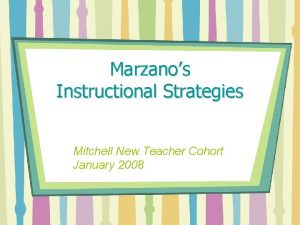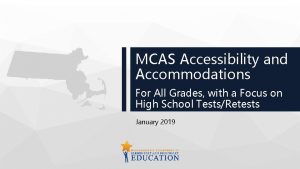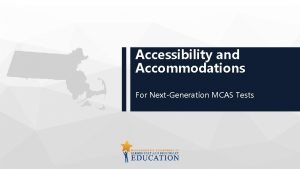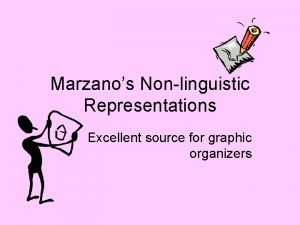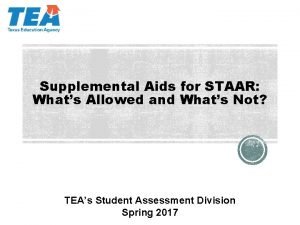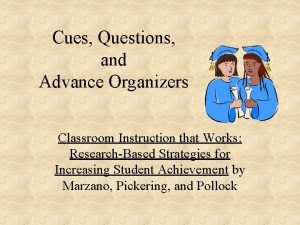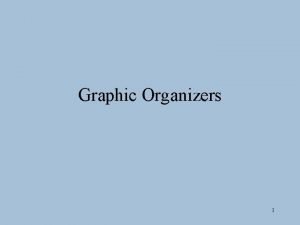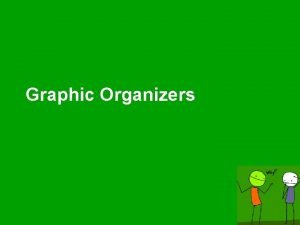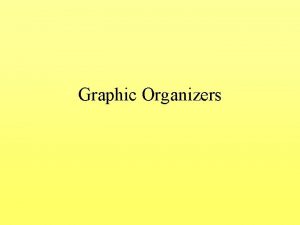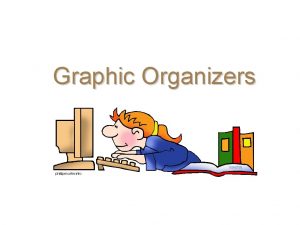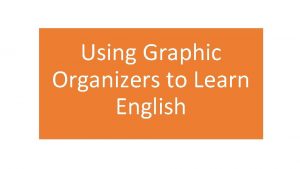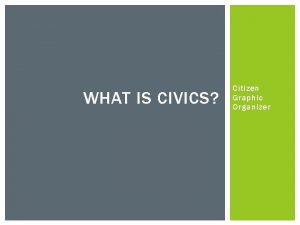What are Graphic Organizers A graphic organizer shows











- Slides: 11


What are Graphic Organizers? • A graphic organizer shows the relationship of concepts or their organization • They are very useful since the user doesn’t have to process a lot of material in order to comprehend the material that is being taught. • Just the Facts!

Some Effective Ways to use Graphic Organizers • Teacher models and provides explanation for the model to students. • Class does it with the teacher • Class does it in cooperative group such as Think, Pair, Share, Jigsaw and other such activities; scaffolding by teacher • Type of activities: – Pre-Writing; Concepts Literature/Reading – Vocabulary Writing Technology (skit, reader theater, filming of meaning of word act out, image of word etc).

Examples of Graphic Organizers • • • K-W-L Charts Mind Map Timelines Cause and Effect Chart Venn Diagram T-Charts Flow Chart Fishbone Story board Spider Thematic Web Many other types (Inspiration)


Graphic Organizers and ELL students Teachers can make content area information more understandable for ELL students by the use of graphic organizers.

BEFORE INSTRUCTION • Provide students structure. • Provide connection for different ideas (compare and contrast). Venn Diagram is a great graphic organizer for this. • Elicit information from students while filling out the graphic organizer on the board. This helps the teacher assess knowledge/understanding.

DURING INSTRUCTION Students recognize information. Students reorganize the information. Students can learn from their own mistakes. Student can construct mental maps that will help them in the future as a reference. • Students can use their own learning style. The learning styles can vary: alternate to auditory (lecture), is visual, and can be non-verbal. • • •

AFTER INSTRUCTION • Students construct their own organizers with key ideas. • Organizers are a great tool to assess students after instruction. • Encourage elaboration. Let them go crazy with ideas! • Connect with prior knowledge.

Teachers • Teachers should: • Describe the graphic organizers use. Why are we using the organizer and how it can help us learn. • Model its use before starting a graphic organizer. • Provide guided practice.

IN SUMMARY • USE THEM! • A graphic organizer can be used to provide learning through a variety of styles such as: – Kinesthetic – Auditory – Visual – Verbal • Contextual Uses – Vocabulary
 Antigentest åre
Antigentest åre Graphic organizer 4 square
Graphic organizer 4 square Marzanos strategies
Marzanos strategies Tea blank graphic organizers
Tea blank graphic organizers Human read aloud mcas
Human read aloud mcas Mcas graphic organizer
Mcas graphic organizer Blank graphic organizers for math staar
Blank graphic organizers for math staar Generalization pattern organizer
Generalization pattern organizer Math supplemental aids
Math supplemental aids Grammar and mechanics rules for staar 2021
Grammar and mechanics rules for staar 2021 When god shows up he shows off
When god shows up he shows off Expository advance organizer
Expository advance organizer


